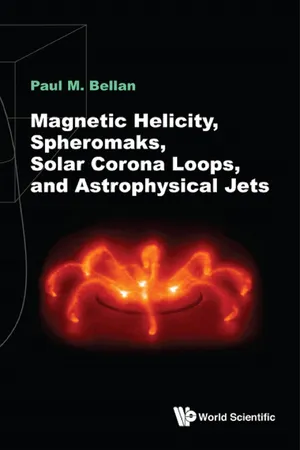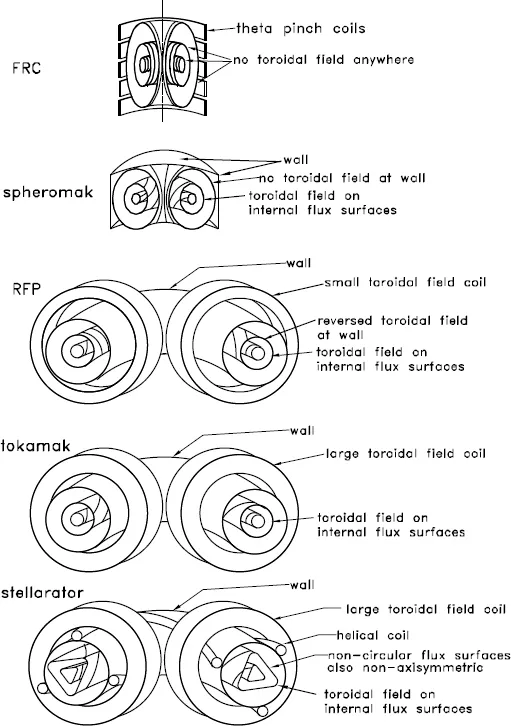
- 652 pages
- English
- ePUB (mobile friendly)
- Available on iOS & Android
Magnetic Helicity, Spheromaks, Solar Corona Loops, and Astrophysical Jets
About this book
-->
Pedagogical in style, this book provides insights into plasma behavior valid over twenty orders of magnitude in both time and space. The book assumes that the reader has a basic knowledge of magnetohydrodynamics and explains topics using detailed theoretical analysis supported by discussion of relevant experiments. This comprehensive approach gives the reader an understanding of the essential theoretical ideas and their application to real situations.
The book starts by explaining the topological concept of magnetic helicity and then develops a helicity-based model that predicts the ultimate state towards which magnetically-dominated plasmas evolve. The model predicts that no matter how messy or complicated the dynamics, a great range of plasma configurations always self-organize to a unique, simple final state. This self-organization, called relaxation, is a fundamental concept that unifies understanding of spheromaks, solar corona loops, interplanetary magnetic clouds, and astrophysical jets.
After establishing why relaxation occurs, the book then examines how relaxation occurs. It shows that relaxation involves a sequence of complex non-equilibrium dynamics including fast self-collimated plasma jets, kink instabilities, magnetic reconnection, and phenomena outside the realm of magnetohydrodynamics.
--> Contents:
- Introduction
- Basic Concepts
- Magnetic Helicity
- Relaxation of an Isolated Configuration to the Taylor State
- Relaxation in Driven Configurations
- The MHD Energy Principle, Helicity, and Taylor States
- Survey of Spheromak Formation Schemes
- Classification of Regimes: An Imperfect Analogy to Thermodynamics
- Analysis of Isolated Cylindrical Spheromaks
- The Role of the Wall
- Analysis of Driven Spheromaks: Strong Coupling
- Helicity Flow and Dynamos
- Confinement and Transport in Spheromaks
- Some Important Practical Issues
- Basic Diagnostics for Spheromaks
- Applications of Spheromaks
- Initial Dynamics Leading to Relaxation: MHD Jets
- Dynamics Associated with Relaxation: Kinks, Rayleigh-Taylor, Hard X-Rays
- Beyond MHD: Whistler Waves and Fast Magnetic Reconnection
- Zero-β Models for Solar and Space Phenomena: Helicity, Force-Free Equilibria
- Finite-β Models and Experiments for Solar Phenomena: Collimation, Flows, Expansion
- Beyond MHD: Extreme Particle Orbits in Helical Magnetic Fields
- Finite-β Toroidal Magnetic Cloud Model
- Astrophysical Jets, Accretion, Angular Momentum Removal, and Space Dynamos
- Appendices:
-
- Vector Identities and Operators
- Bessel Orthogonality Relations
- Capacitor Banks
- Transmission Lines, Pulse Forming Networks, and Transformers
- Selected Formulae
-->
--> Readership: Researchers, graduate students, and advanced undergraduates in plasma physics, solar physics, and astrophysics; mathematicians interested in helicity, topology, and self-organization. -->
Keywords:Magnetohydrodynamics;Magnetic Helicity;Spheromaks;MHD;MHD Jets;Kink;Rayleigh Taylor;Accretion Disk;Astrophysical Jet;Solar Prominence;Solar Corona;Solar Corona Loop;CME;Relative Helicity;Taylor Relaxation;Magnetic Reconnection;Whistler Waves;Hall MHD;Electron MHD;Alfven Waves;Magnetic Clouds;Canonical Angular Momentum;Magnetic BrakingReview: Key Features:
- Unique, no completing titles
- This new revision contains discussion of dynamics underlying self-organization (Taylor relaxation)
- This new revision contains updates on spheromak research since 2000
Frequently asked questions
- Essential is ideal for learners and professionals who enjoy exploring a wide range of subjects. Access the Essential Library with 800,000+ trusted titles and best-sellers across business, personal growth, and the humanities. Includes unlimited reading time and Standard Read Aloud voice.
- Complete: Perfect for advanced learners and researchers needing full, unrestricted access. Unlock 1.4M+ books across hundreds of subjects, including academic and specialized titles. The Complete Plan also includes advanced features like Premium Read Aloud and Research Assistant.
Please note we cannot support devices running on iOS 13 and Android 7 or earlier. Learn more about using the app.
Information
Chapter 1
Introduction
1.1Brief description of spheromaks


Table of contents
- Cover Page
- Title
- Copyright
- Contents
- Preface
- 1. Introduction
- 2. Basic Concepts
- 3. Magnetic Helicity
- 4. Relaxation of an Isolated Configuration to the Taylor State
- 5. Relaxation in Driven Configurations
- 6. The MHD Energy Principle, Helicity, and Taylor States
- 7. Survey of Spheromak Formation Schemes
- 8. Classification of Regimes: An Imperfect Analogy to Thermodynamics
- 9. Analysis of Isolated Cylindrical Spheromaks
- 10. The Role of the Wall
- 11. Analysis of Driven Spheromaks: Strong Coupling
- 12. Helicity Flow and Dynamos
- 13. Confinement and Transport in Spheromaks
- 14. Some Important Practical Issues
- 15. Basic Diagnostics for Spheromaks
- 16. Applications of Spheromaks
- 17. Initial dynamics leading to relaxation: MHD jets
- 18. Dynamics associated with relaxation: Kinks, Rayleigh-Taylor, Hard X-rays
- 19. Beyond MHD: Whistler Waves and Fast Magnetic Reconnection
- 20. Zero-β models for solar and space phenomena: Helicity, force-free equilibria
- 21. Finite-β models and experiments for solar phenomena: collimation, flows, expansion
- 22. Beyond MHD: Extreme particle orbits in helical magnetic fields
- 23. Finite-β toroidal magnetic cloud model
- 24. Astrophysical Jets, Accretion, Angular Momentum Removal, and Space Dynamos
- Appendix A Vector Identities and Operators
- Appendix B Bessel Orthogonality Relations
- Appendix C Capacitor Banks
- Appendix D Transmission lines, pulse forming networks, and transformers
- Appendix E Selected Formulae
- Bibliography
- Index